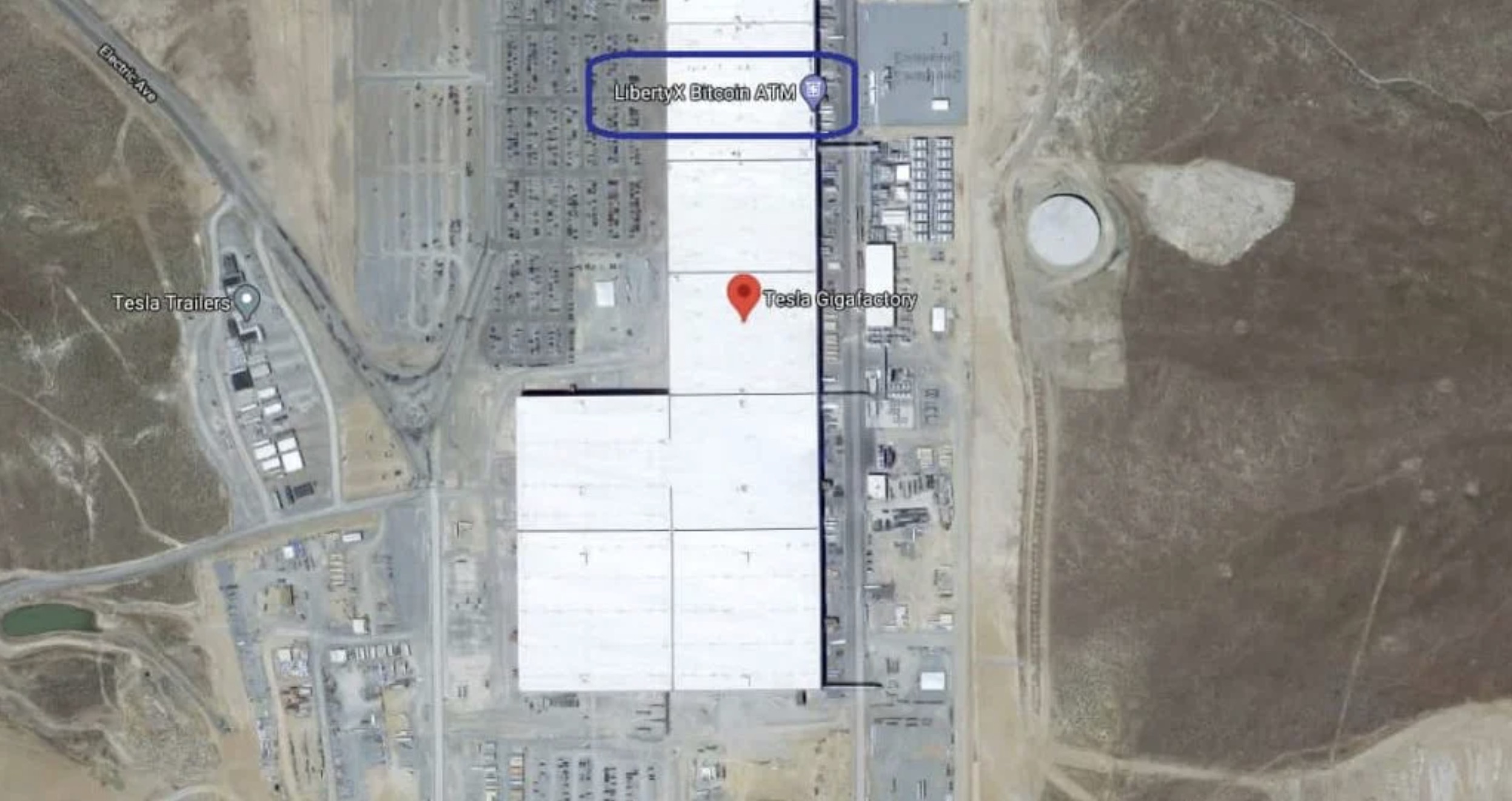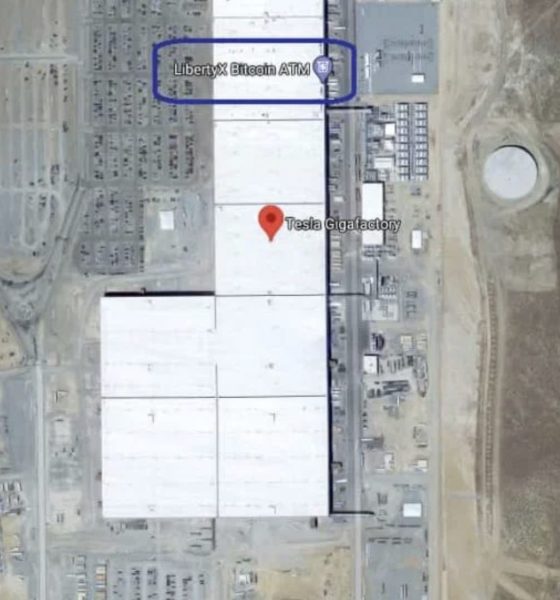

News
UPDATE: Tesla gets progressive with Bitcoin ATMs at factories, claims report
Note: In a recent post on Twitter, CEO Elon Musk has noted that he does not believe the report of Bitcoin ATMs in Tesla’s factories is accurate.
Tesla, being as forward-thinking as ever, now has Bitcoin ATMs at the Fremont Factory and Gigafactory Nevada.
One of the Bitcoin ATMs was originally spotted by Twitter user Will Reeves. LibertyX, the company responsible for the Bitcoin ATMs, reached out to Finbold and confirmed Reeves’ sighting in an official statement.
“The Tesla locations have been live since August. The ATM is currently only accessible for employees,” LibertyX told Finbold.
The Bitcoin ATM company also stated that it did not install a new kiosk at Gigafactory Nevada. It simply added Bitcoin-selling features via software to three ATMs in the facility that were already installed.
Just passed by and saw @elonmusk has a bitcoin atm at the Gigafactory. pic.twitter.com/8HpkDkFwqP— WILL REEVES (@wlrvs) October 10, 2020
A quick search through LibertyX’s website revealed that Tesla also has a Bitcoin ATM in the Fremont Factory for employees to use.
Avid Tesla supporters know the intriguing relationship Elon Musk has with cryptocurrencies and crypto scammers.
Just this past June, crypto scammers used Elon Musk and SpaceX to steal up to $150,000 from YouTube viewers. The scammers convinced viewers to send Bitcoin to several YouTube channels by hacking legitimate accounts and rebranding them to fit their purpose.
They used archived footage of Elon Musk to broadcast a live event and convince viewers the channels were authentic. Other scammers went a step further and copied Elon Musk’s Twitter account, confusing his followers.
I’m going to keep banging on about this until twitter sorts it: When I look at a trump tweet, 1 of top replies is always scam re: an Elon Musk BTC giveaway. It has a reply from stolen verified acct, being used to pump scam, which is why I guess it appears high up. pic.twitter.com/Wi3RKyVmPN— David Osborn (@david_osborn) March 18, 2020
Despite crypto scammers using his identity and his companies’ brands for their schemes, Elon Musk remains a supporter of cryptocurrencies and an influential figure in the crypto industry, according to Cointelegraph.
He has applauded Bitcoin, in particular, for having a “brilliant” structure. The installation of two Bitcoin ATMs in two Tesla Gigafactories suggests that Musk’s stance on cryptocurrencies still holds.
The Tesla CEO might not stop at installing Bitcoin ATMs in just two Gigafactories either. LibertyX stated that it has more Bitcoin ATMs ready for installation.
I still only own 0.25 Bitcoins btw— Elon Musk (@elonmusk) May 15, 2020
“LibertyX has partnered with the two largest ATM manufacturers (Genmega and Hyosung) to offer bitcoin software preinstalled on traditional ATMs. Once operators activate the feature, consumers can start buying bitcoin with their debit card from ATMs nationwide. We have 5,000 ATMs already live and plan to roll it out at over 100,000 ATMs over the next few years,” the company explained further.
LibertyX did not state that more of its Bitcoin ATMs would be installed at Tesla’s factories. However, it is a possibility, especially if the Bitcoin ATMs in Nevada and Fremont are popular with the employees.
They have the best coin— Elon Musk (@elonmusk) March 3, 2020
If the Bitcoin ATMs do become a hit, Elon Musk may start thinking of installing Dogecoin ATMs as well. After all, Musk was briefly the CEO of Dogecoin, and the cryptocurrency’s meme origins fit perfectly with his online tendencies.

Elon Musk
Elon Musk’s X will start using a Tesla-like software update strategy
The initiative seems designed to accelerate updates to the social media platform, while maintaining maximum transparency.

Elon Musk’s social media platform X will adopt a Tesla-esque approach to software updates for its algorithm.
The initiative seems designed to accelerate updates to the social media platform, while maintaining maximum transparency.
X’s updates to its updates
As per Musk in a post on X, the social media company will be making a new algorithm to determine what organic and advertising posts are recommended to users. These updates would then be repeated every four weeks.
“We will make the new 𝕏 algorithm, including all code used to determine what organic and advertising posts are recommended to users, open source in 7 days. This will be repeated every 4 weeks, with comprehensive developer notes, to help you understand what changed,” Musk wrote in his post.
The initiative somewhat mirrors Tesla’s over-the-air update model, where vehicle software is regularly refined and pushed to users with detailed release notes. This should allow users to better understand the details of X’s every update and foster a healthy feedback loop for the social media platform.
xAI and X
X, formerly Twitter, has been acquired by Elon Musk’s artificial intelligence startup, xAI last year. Since then, xAI has seen a rapid rise in valuation. Following the company’s the company’s upsized $20 billion Series E funding round, estimates now suggest that xAI is worth tens about $230 to $235 billion. That’s several times larger than Tesla when Elon Musk received his controversial 2018 CEO Performance Award.
As per xAI, the Series E funding round attracted a diverse group of investors, including Valor Equity Partners, Stepstone Group, Fidelity Management & Research Company, Qatar Investment Authority, MGX, and Baron Capital Group, among others. Strategic partners NVIDIA and Cisco Investments also continued support for building the world’s largest GPU clusters.
News
Tesla FSD Supervised wins MotorTrend’s Best Driver Assistance Award
The decision marks a notable reversal for the publication from prior years, with judges citing major real-world improvements that pushed Tesla’s latest FSD software ahead of every competing ADAS system.

Tesla’s Full Self-Driving (Supervised) system has been named the best driver-assistance technology on the market, earning top honors at the 2026 MotorTrend Best Tech Awards.
The decision marks a notable reversal for the publication from prior years, with judges citing major real-world improvements that pushed Tesla’s latest FSD software ahead of every competing ADAS system. And it wasn’t even close.
MotorTrend reverses course
MotorTrend awarded Tesla FSD (Supervised) its 2026 Best Tech Driver Assistance title after extensive testing of the latest v14 software. The publication acknowledged that it had previously criticized earlier versions of FSD for erratic behavior and near-miss incidents, ultimately favoring rivals such as GM’s Super Cruise in earlier evaluations.
According to MotorTrend, the newest iteration of FSD resolved many of those shortcomings. Testers said v14 showed far smoother behavior in complex urban scenarios, including unprotected left turns, traffic circles, emergency vehicles, and dense city streets. While the system still requires constant driver supervision, judges concluded that no other advanced driver-assistance system currently matches its breadth of capability.
Unlike rival systems that rely on combinations of cameras, radar, lidar, and mapped highways, Tesla’s FSD operates using a camera-only approach and is capable of driving on city streets, rural roads, and freeways. MotorTrend stated that pure utility, the ability to handle nearly all road types, ultimately separated FSD from competitors like Ford BlueCruise, GM Super Cruise, and BMW’s Highway Assistant.
High cost and high capability
MotorTrend also addressed FSD’s pricing, which remains significantly higher than rival systems. Tesla currently charges $8,000 for a one-time purchase or $99 per month for a subscription, compared with far lower upfront and subscription costs from other automakers. The publication noted that the premium is justified given FSD’s unmatched scope and continuous software evolution.
Safety remained a central focus of the evaluation. While testers reported collision-free operation over thousands of miles, they noted ongoing concerns around FSD’s configurable driving modes, including options that allow aggressive driving and speeds beyond posted limits. MotorTrend emphasized that, like all Level 2 systems, FSD still depends on a fully attentive human driver at all times.
Despite those caveats, the publication concluded that Tesla’s rapid software progress fundamentally reshaped the competitive landscape. For drivers seeking the most capable hands-on driver-assistance system available today, MotorTrend concluded Tesla FSD (Supervised) now stands alone at the top.
News
Elon Musk’s Grokipedia surges to 5.6M articles, almost 79% of English Wikipedia
The explosive growth marks a major milestone for the AI-powered online encyclopedia, which was launched by Elon Musk’s xAI just months ago.

Elon Musk’s Grokipedia has grown to an impressive 5,615,201 articles as of today, closing in on 79% of the English Wikipedia’s current total of 7,119,376 articles.
The explosive growth marks a major milestone for the AI-powered online encyclopedia, which was launched by Elon Musk’s xAI just months ago. Needless to say, it would only be a matter of time before Grokipedia exceeds English Wikipedia in sheer volume.
Grokipedia’s rapid growth
xAI’s vision for Grokipedia emphasizes neutrality, while Grok’s reasoning capabilities allow for fast drafting and fact-checking. When Elon Musk announced the initiative in late September 2025, he noted that Grokipedia would be an improvement to Wikipedia because it would be designed to avoid bias.
At the time, Musk noted that Grokipedia “is a necessary step towards the xAI goal of understanding the Universe.”
Grokipedia was launched in late October, and while xAI was careful to list it only as Version 0.1 at the time, the online encyclopedia immediately earned praise. Wikipedia co-founder Larry Sanger highlighted the project’s innovative approach, noting how it leverages AI to fill knowledge gaps and enable rapid updates. Netizens also observed how Grokipedia tends to present articles in a more objective manner compared to Wikipedia, which is edited by humans.
Elon Musk’s ambitious plans
With 5,615,201 total articles, Grokipedia has now grown to almost 79% of English Wikipedia’s article base. This is incredibly quick, though Grokipedia remains text-only for now. xAI, for its part, has now updated the online encyclopedia’s iteration to v0.2.
Elon Musk has shared bold ideas for Grokipedia, including sending a record of the entire knowledge base to space as part of xAI’s mission to preserve and expand human understanding. At some point, Musk stated that Grokipedia will be renamed to Encyclopedia Galactica, and it will be sent to the cosmos.
“When Grokipedia is good enough (long way to go), we will change the name to Encyclopedia Galactica. It will be an open source distillation of all knowledge, including audio, images and video. Join xAI to help build the sci-fi version of the Library of Alexandria!” Musk wrote, adding in a later post that “Copies will be etched in stone and sent to the Moon, Mars and beyond. This time, it will not be lost.”








